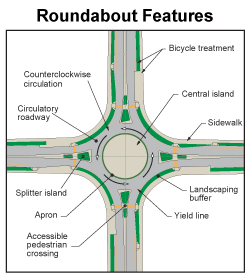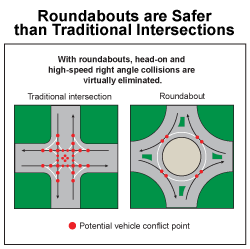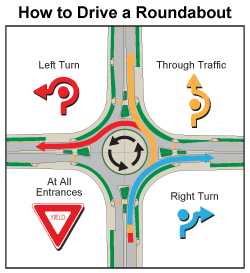A roundabout is a circular intersection or junction in which road traffic flows almost continuously in one direction around a central island.
Modern roundabouts are different from rotaries and other traffic circles. Roundabouts are typically smaller than the large, high-speed rotaries still in use in some parts of the country and are usually larger than neighborhood traffic circles used to calm traffic.
INDOT is using roundabouts to replace traditional four-way traffic signals to reduce accidents, traffic delays, fuel consumption, air pollution and construction costs, while improving safety, increasing capacity and enhancing intersection beauty.
Roundabouts have been successfully used to reduce congestion in residential neighborhoods and are accepted as one of the safest types of intersection designs.
Roundabouts are becoming a relatively common traffic feature in Indiana, with more than 256 constructed through 2016 by both INDOT and cities and towns. More than a dozen additional roundabouts are currently being planned by INDOT.
- Roundabout Features
All modern roundabouts share the same features. These include:
 Yield-at-entry: Traffic entering the circle yields to traffic already in the circle.
Yield-at-entry: Traffic entering the circle yields to traffic already in the circle.- Traffic deflection: Pavement markings and raised islands direct traffic into a one-way counterclockwise flow.
- Geometric curvature: The radius of the circular road and the angles of entry are designed to slow the speed of vehicles.
- Roundabout History
Traffic circles have been part of the transportation system in the United States since at least 1905 when one of the first circles was built in New York City. Subsequently, many large circles or rotaries were built in the United States. The prevailing designs enabled high-speed merging and weaving of vehicles. Priority was given to entering vehicles, facilitating high-speed entries. High numbers of crashes and congestion in the circles led to rotaries falling out of favor in America after the mid-1950s.
The modern roundabout was developed in the United Kingdom to rectify problems associated with these traffic circles. In 1966, the United Kingdom adopted a rule that required traffic entering circling intersections to yield to circulating traffic. This rule prevented circular intersections from locking up by not allowing vehicles to enter the intersection until there were sufficient gaps in circulating traffic. In addition, smaller circular intersection designs slowed vehicle entry and circulating speeds. These changes significantly improved the safety characteristics of roundabouts by reducing the number and the severity of crashes.

There are an estimated 300,000 signalized intersections in the United States, according to the Federal Highway Administration. About one-third of all intersection fatalities occur at these locations, resulting in roughly 2,300 people killed each year. Furthermore, about 700 people are killed annually in red-light running collisions.
Roundabouts have demonstrated substantial safety and operational benefits compared to most other intersection forms and controls, with especially significant reductions in fatal and injury crashes. Because the only movement allowed upon entry or exit from a roundabout is a right turn, the occurrence of crashes that result in injury is substantially reduced. Small-angle collisions, the type of collisions that can occur as a result of a right-hand turn, are typically less severe than other types of collisions.
- How to Drive a Roundabout
Approach:
- Slow down and stay in your lane

- Yield to vehicles already in the roundabout
- Obey one-way signs at all times
- Yield to pedestrians and bicycles if there is a crosswalk
Enter:
- Wait for traffic in the roundabout; it has the right-of-way
- When traffic clears, merge to the right and continue to stay in your lane
Proceed:
- Continue through the roundabout until you reach your exit point. Avoid stopping in the roundabout
Exit:
- Signal and exit to the right
- Left turns are completed by circling around the center island and then making a right turn to exit
Roundabouts can easily accommodate emergency and large-sized vehicles. Drivers should behave in the same manner as they would on any other road if an emergency vehicle approaches: carefully move as far right as possible and, if necessary, stop until the emergency vehicle passes.
- Slow down and stay in your lane
- Benefits of a Roundabout
Lives saved:
- Roundabouts reduce the number of potential accident points within an intersection
- Up to a 90 percent reduction in fatalities
- 76 percent reduction in injury crashes
- 30-40 percent reduction in pedestrian crashes
- 75 percent fewer conflict points than four-way intersections
Slower vehicle speeds:
- Drivers have more time to judge and react to other cars or pedestrians
- Advantageous to mature and novice drivers
- Reduces the severity of crashes
- Keeps pedestrians safer
Efficient traffic flow:
- 30-50 percent increase in traffic capacity
- Improves traffic flow for intersections that handle a high number of left turns
- Reduces need for turn lanes
Money saved:
- No signal equipment to install and repair
- Savings estimated at an average of $5,000 per year in electricity and maintenance costs
- Service life of a roundabout is 25 years (vs. the 10-year service life of signal equipment)
Community benefits:
- Traffic calming
- Aesthetic landscaping
- Reduces congestion
- Reduces pollution and fuel use
Related Links
Contact Information
Transportation Services Call Center
Indiana Department of Transportation
100 N. Senate Ave., IGCN 755
Indianapolis, IN 46204
855-463-6848
indot4u.com
